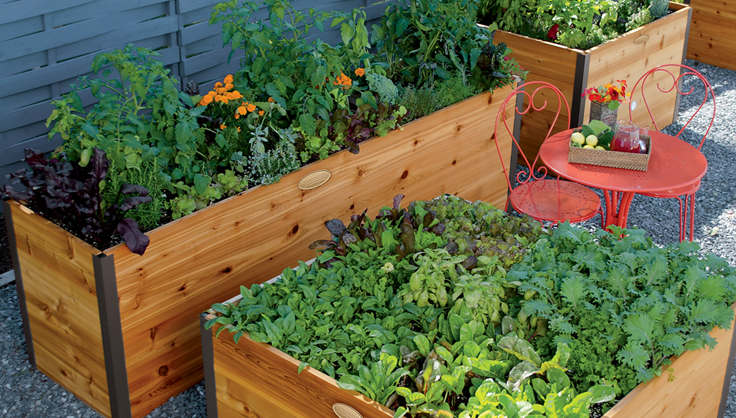Grow Higher: Elevated Raised Garden Beds
Elevate the benefits of raised bed gardening to waist height
 Elevated raised beds can be used to grow vegetables or flowers.
Elevated raised beds can be used to grow vegetables or flowers.By growing in a raised bed, you can have a productive, abundant vegetable garden — even in just a few square feet. Even better, the elevated styles put the garden right at your fingertips for comfortable "no bend" gardening. Keep in mind that elevated gardens can dry out more rapidly, so you should monitor the bed every few days to check the moisture of the soil. Properly maintained wooden beds will last at least 5+ years and up to twice that or more. Metal beds will often last even longer (20 years plus). Raised beds do not need new soil every year, but the bed’s nutrients should be replenished yearly with our Raised Bed Booster Compost Mix Kit: Organic Compost Plus: Raised Bed Booster Kit | Gardener's Supply.
Here's how to make the most of your elevated raised bed:
Choosing Your Soil
- Fill your bed with potting soil that's formulated for raised beds and planters, such as our potting mix. Don't use ordinary garden soil; It won't drain properly. To figure out how much soil you need, use the Soil Calculator. If it's a Gardener's Supply bed, you'll find the soil quantity listed with the product details.
- When you're filling the beds, be sure to mix in some granular fertilizer, which will get the plants off to a good start. Follow up later in the season with regular applications of liquid fertilizer.
Where to Place Your Elevated Raised Bed
- Pick a sunny site; vegetables need at least eight hours of sun each day.3 A deck or patio is a great location for just about anything; a covered porch is best for shade-loving annuals.
- Make sure you have easy access to water.
What to Plant
- Because elevated raised beds are compact, choose varieties that are known for their compact habit.
- Every year, try to include at least one variety that's new to you. Discovery is half the fun!
- If you're new to gardening, check out the Kitchen Garden Planner, where you can find pre-planned gardens that are designed to fit elevated raised beds.
When to Plant
- Wait until danger of frost has passed. Check with your county's Cooperative Extension Service to get the dates, or use an online resource. Better yet, ask the best gardener in your neighborhood or a Master Gardener.
- If you're starting from seed, create a seed-starting schedule. Use the information on the seed packet to guide you.
- Crops that are tolerant of cool weather can be planted earlier, using season-extending techniques.
Don't Forget to Water!
- Use your finger to check moisture levels throughout the season. The soil should be moist but not water-logged.4 Allow it to dry out a bit between waterings.
- Tiny seedlings require daily water — their root systems are too small and shallow!
- To automate the process, install a timer and a watering system, such as Snip-n-Drip.
Grow Vertically
- Maximize your space by growing your vining plants vertically.1 Peas, beans, cucumbers, tomatoes, and squash will all benefit from a trellis or other type of plant support that will keep fruits up off the soil. Plant supports also increase air flow between plants, which helps to prevent disease.2
Sources
1 Intensive Gardening Methods | VCE Publications | Virginia Tech
2 Trellising, Staking, and Caging (A3933-01)
3 Sunlight: The Key to Great Vegetables | CALS
4 Smart watering in the vegetable garden - Gardening in Michigan
Print this Article:
Get the Dirt
Stay up to date on new articles and advice. Please fill out the information below.







